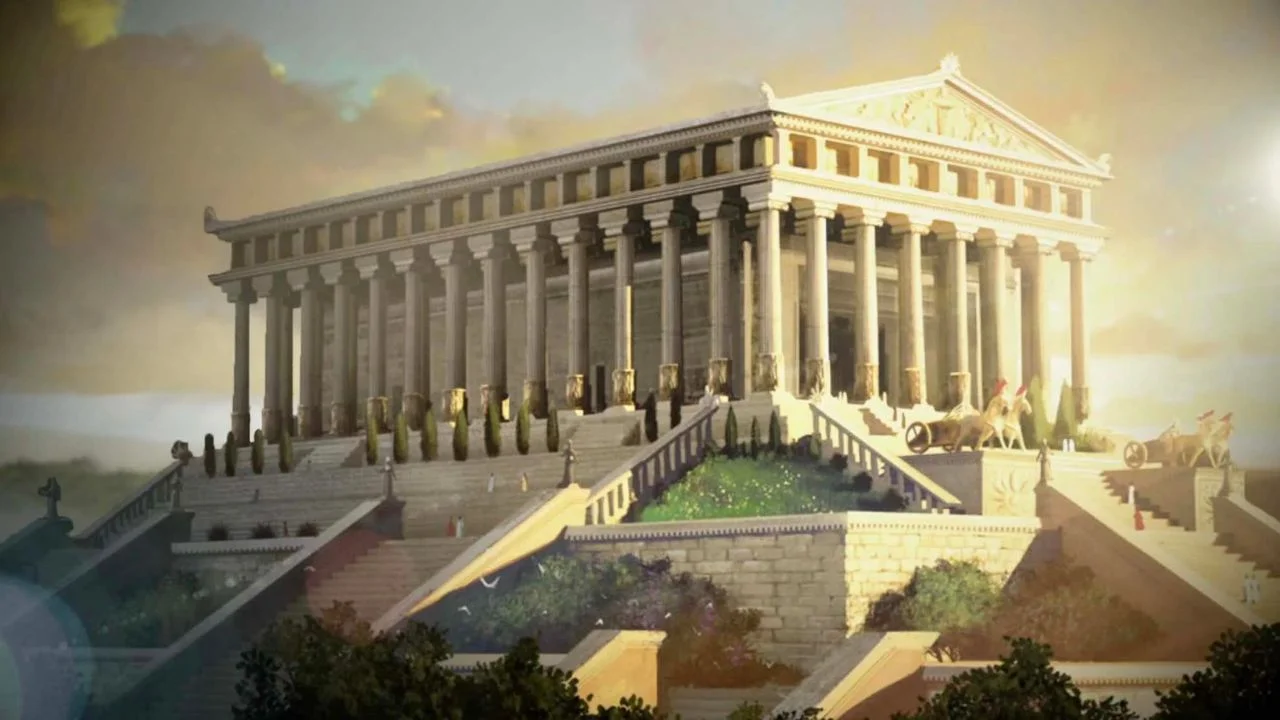Rome: The Eternal City’s Architectural Triumphs
Rome, often called the Eternal City, stands as a testament to the grandeur of the Roman Empire, which once stretched across three continents. Its ancient wonders, including the Colosseum and the Pantheon, embody the empire’s engineering prowess, cultural richness, and enduring legacy.
The Colosseum: A Symbol of Power and Spectacle
The Colosseum, completed in 80 CE under Emperor Vespasian and his successor Titus, remains one of the most recognizable symbols of Rome. This massive amphitheater, originally known as the Flavian Amphitheatre, could hold up to 80,000 spectators, who gathered to witness gladiatorial contests, animal hunts, and public spectacles. Constructed from concrete, travertine, and tuff, the Colosseum’s innovative design included a complex system of vaults and arches, showcasing Roman engineering at its peak.
The structure’s elliptical shape and tiered seating allowed for efficient crowd management, while its underground hypogeum—a network of tunnels and chambers—facilitated elaborate stagecraft, including trapdoors and lifts for dramatic entrances. The Colosseum was not merely a venue for entertainment; it was a political tool, used by emperors to demonstrate their power and curry favor with the masses through free spectacles.
Today, the Colosseum stands as a UNESCO World Heritage Site, drawing millions of visitors annually. Despite damage from earthquakes and centuries of stone quarrying, its enduring presence speaks to the durability of Roman construction techniques. It also serves as a poignant reminder of the complex interplay between grandeur and brutality in Roman society, where entertainment often came at the cost of human and animal lives.
The Pantheon: A Temple to the Gods
Equally remarkable is the Pantheon, a temple dedicated to all Roman gods, commissioned by Emperor Hadrian around 126 CE. Its most striking feature is its massive unreinforced concrete dome, which remains the largest of its kind in the world. The dome’s oculus, a circular opening at its apex, allows natural light to illuminate the interior, creating a spiritual ambiance that connects the earthly and divine.
The Pantheon’s architectural genius lies in its harmonious proportions and innovative use of materials. The dome’s weight is distributed through a series of relieving arches and a gradual thinning of the concrete as it rises, demonstrating Roman mastery of structural engineering. The interior, adorned with marble and intricate designs, reflects the opulence of imperial Rome.
Converted into a Christian church in the 7th century, the Pantheon has been in continuous use, preserving its structure remarkably well. Its influence is evident in architectural masterpieces like the U.S. Capitol and St. Peter’s Basilica. Visiting the Pantheon today evokes a sense of timelessness, as its serene interior invites contemplation of Rome’s spiritual and intellectual legacy.
Athens: The Birthplace of Democracy and Philosophy
Athens, the cradle of Western civilization, is synonymous with intellectual and cultural achievements. Its ancient wonders, centered around the Acropolis and its crowning jewel, the Parthenon, symbolize the city’s contributions to democracy, philosophy, and the arts.
The Acropolis: A Citadel of Culture
Perched atop a rocky hill, the Acropolis has been a focal point of Athenian life since the Bronze Age. By the 5th century BCE, under the leadership of Pericles, it became a showcase of Athenian power and artistic excellence. The Acropolis complex includes several structures, but the Parthenon, Erechtheion, and Temple of Athena Nike stand out for their architectural and historical significance.
The Acropolis was more than a religious sanctuary; it was a statement of Athenian identity. Its elevated position symbolized the city’s aspirations, while its temples and statues celebrated the gods and heroes central to Athenian mythology. The site’s strategic location also made it a defensive stronghold, reflecting the dual role of religion and security in ancient Greek society.
The Parthenon: A Masterpiece of Classical Architecture
The Parthenon, built between 447 and 432 BCE, is the epitome of Doric architecture. Designed by architects Ictinus and Callicrates and adorned with sculptures by Phidias, it was dedicated to Athena, the goddess of wisdom and warfare. The temple’s harmonious proportions, achieved through subtle refinements like the slight curvature of its columns, create an illusion of perfection that has inspired architects for centuries.
Constructed from Pentelic marble, the Parthenon gleamed white in its prime, with vibrant painted details. Its friezes and metopes depicted mythological battles and civic processions, blending art with civic pride. The temple housed a colossal statue of Athena, crafted from gold and ivory, symbolizing Athens’ wealth and devotion.
Despite centuries of damage from wars, looting, and environmental factors, the Parthenon remains a global icon. The Elgin Marbles, a collection of its sculptures now housed in the British Museum, continue to spark debates about cultural heritage and repatriation. Visiting the Acropolis today, one feels the weight of history—a connection to the philosophers, playwrights, and statesmen who shaped Western thought.
Cairo: The Timeless Wonders of Ancient Egypt
Cairo, the gateway to ancient Egypt, is home to the Pyramids of Giza and the Great Sphinx, monuments that have captivated the imagination for millennia. These structures, built by the Old Kingdom pharaohs, reflect Egypt’s spiritual depth, architectural ambition, and organizational genius.
The Pyramids of Giza: Tombs of Eternity
The Giza Plateau, just outside Cairo, hosts the Great Pyramid of Khufu, along with the pyramids of Khafre and Menkaure. Built around 2630 BCE, the Great Pyramid is the largest and most famous, standing at 146.5 meters tall. Constructed from over 2.3 million limestone blocks, it was the tallest man-made structure for nearly 4,000 years.
The pyramids served as tombs for pharaohs, designed to ensure their safe passage to the afterlife. Their precise alignment with the cardinal points and the stars suggests a deep understanding of astronomy, while their construction required sophisticated logistics and engineering. Scholars estimate that tens of thousands of skilled workers, supported by a complex supply chain, built these monuments over decades.
The Great Pyramid’s interior, with its Grand Gallery and King’s Chamber, reveals the Egyptians’ mastery of stonework and their reverence for the divine. The pyramid’s enduring mystery—how it was built with such precision using ancient tools—continues to spark fascination and debate. Theories range from ramps and levers to more speculative ideas, but the absence of definitive records only adds to the pyramid’s allure.
The Great Sphinx: Guardian of the Plateau
Adjacent to the pyramids stands the Great Sphinx, a limestone monument with the body of a lion and the head of a human, likely representing Pharaoh Khafre. Carved around 2550 BCE, it measures 73 meters long and 20 meters high, making it one of the largest monolithic statues in the world. The Sphinx’s enigmatic expression and weathered features have inspired countless myths, including its association with riddles in Greek mythology.
The Sphinx’s purpose remains debated—was it a guardian of the necropolis, a symbol of royal power, or a representation of the sun god Ra? Its nose, famously missing, has fueled speculation about vandalism, erosion, or even cannon fire. Ongoing restoration efforts aim to preserve this iconic monument, which continues to stand sentinel over the Giza Plateau.
Visiting Giza today, one is struck by the scale and permanence of these structures, set against the backdrop of modern Cairo. The juxtaposition of ancient and contemporary life underscores Egypt’s unbroken connection to its past, making the pyramids and Sphinx enduring symbols of human ambition.
The Enduring Legacy of Ancient Wonders
The ancient wonders of Rome, Athens, and Cairo are more than architectural feats; they are windows into the values, beliefs, and aspirations of their creators. The Colosseum and Pantheon reflect Rome’s imperial might and spiritual depth, the Acropolis and Parthenon embody Athens’ intellectual and artistic zenith, and the Pyramids and Sphinx capture Egypt’s obsession with eternity and divine order. Together, they represent the pinnacle of human achievement in the ancient world.
These monuments have weathered millennia, surviving wars, natural disasters, and cultural shifts. They have inspired architects, artists, and thinkers across generations, from Renaissance builders to modern urban planners. Their preservation, however, is a shared responsibility. UNESCO designations, restoration projects, and ethical tourism are critical to ensuring these wonders endure for future generations.
For travelers, visiting these sites is a journey through time. Standing in the Colosseum’s arena, one can almost hear the roar of ancient crowds. Atop the Acropolis, the Parthenon’s columns frame breathtaking views of Athens, evoking the city’s golden age. At Giza, the pyramids’ sheer scale humbles even the most seasoned explorer, while the Sphinx gazes silently, guarding secrets of the past.
Conclusion: A Call to Reflect and Preserve
The ancient wonders of Rome, Athens, and Cairo are not merely relics; they are living testaments to humanity’s capacity for greatness. They remind us of our shared heritage and the ingenuity that transcends time and culture. As we marvel at their beauty, we must also commit to their preservation, ensuring that future generations can experience the same awe and inspiration.
In a world of rapid change, these monuments anchor us to our past, offering lessons in resilience, creativity, and the pursuit of meaning. Whether you stand beneath the Pantheon’s oculus, climb the Acropolis’ sacred hill, or gaze upon the Pyramids’ timeless silhouette, you are part of a continuum—a story that began thousands of years ago and continues to unfold.




Leave a Reply